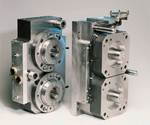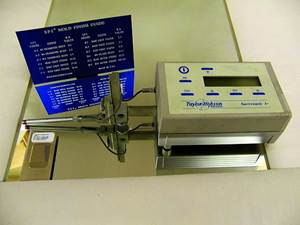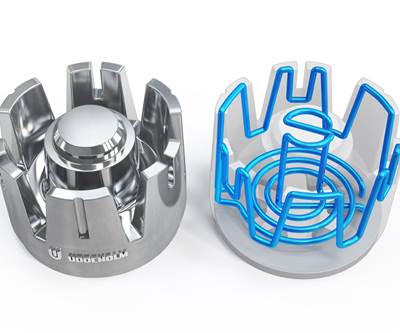An injection-molded part is only as good as the mold that produces it. If a mold prematurely fails during production, it’s not only bad news for the molder who loses valuable production time — and possibly even a customer — but especially for the moldmaker, who promises his customers a long service life, fast injection cycles and clean surfaces.
If damage to the injection mold occurs before it reaches the required service, the material is usually suspected. “Customers only contact us when a tool fails and unfortunately, less often when it comes to initial material selection, optimum heat treatment or tool design,” Dr. Alf Schürmann from Voestalpine High Performance Metals Germany GmbH, member of the Böhler Technology Team around Dr. Ingrid Jung says. “If it comes to tool failure due to inappropriate steel grades, typically the moldmaker has either chosen the wrong steel or accidentally grabbed the wrong blank from the shelf.”
The first step to determining the reason for mold failure should be a damage analysis of the mold’s condition. “You have to know the history,” Schürmann says. “Selected material, heat treatment, mold design, location of highest loads on the mold during production, etc. These factors must be considered to determine the cause of damage.”
Here are some of the most common types of mold damage, practical examples, causes and possible solutions.
Severe Corrosion After Short Service Life
When a customer's mold insert showed severe corrosion after a very short service period, he wanted to get to the bottom of the cause. The material used was a Böhler M340 ISOPLAST, a high-performance plastic mold steel with excellent corrosion resistance properties, high wear resistance and good machinability.
The chemical analysis of the corroded part showed that a non-corrosion resistant tool steel (1.2343, H11) was used instead of the given material. “The cause in such cases is very simple and not so rare,” Schürmann explains. “Especially with smaller shops without electronic warehouse management in place, material mix-ups are more common than one might assume. Sometimes the material is not clearly identified or stored in the wrong place.”
Corrosion in Cooling Channels
If cracks occur in the cooling channels of mold inserts, one of the causes may be crevice corrosion between the brass plug and the steel surface in the cooling channel (see photo), even if the builder selected corrosion-resistant steel. Here, the crack passes from the thread of the stopper into the mold contour.
According to Schürmann, the first assumption is a ductility or toughness problem in the material. However, the real issue is elsewhere. Due to an increasing use of conformal cooling channels, which — as the name suggests — are much closer to the mold contour than conventional channels, cracks reach the mold surface much quicker.
“What happened, in this case, is contact corrosion between brass and steel, which are connected conductively and exhibit different potential for corrosion. The mold acts as a sacrificial anode that is attacked by corrosion and low-quality coolant,” Schürmann explains. “So the builder must minimize the extent of contact corrosion, preferably with plugs made of high-strength plastics or separating the two electrodes (galvanic, PTFE, silicone, etc.). Optimum cooling water quality also contributes to corrosion protection.”
Material Cracks
Material cracks can occur during heat treatment, but the mold design can also be the cause. Common areas of cracking include sharp edges and sharp cross-sectional transitions. “These design features result in a high notch effect (uneven stress distribution) that causes a latent risk of cracking during quenching. But obviously, the heat treater can only draw attention to this problem with externally visible notches (stress peaks),” Schürmann says. So, during mold design, a designer should consider heat treatment and potential risks by providing large radii for critical areas, designing the part “heat-treatment-appropriate” and machining the final contour after heat treatment, if necessary.
Microcracking
A major concern for moldmakers is microcracks present in the mold. One of Schürmann’s customers was looking for the cause of material cracks around the gate area in a mold insert made from corrosion-resistant PM steel. Crack analysis showed an altered metal zone affected by the EDM process in the recast layer, or white layer. This layer has been heated to the point of a molten state, but not quite hot enough to be ejected into the gap and be flushed away. The EDM process altered the metallurgical structure and characteristics in this layer as it is formed by the unexpelled (material not forced out) molten metal being rapidly cooled by the dielectric fluid during the flushing process and resolidification in the cavity.
Microcracking can cause premature failure of the part.
“Microcracking is extremely prominent in the white layer. If this layer is too thick or the builder does not remove it with finer EDM finishes, polishing or additional annealing, the effects of this microcracking can cause premature failure of the part, where in this example, a very hard, brittle microstructure with 61 HRC added to the problem,” Schürmann explains.
To increase mold life, Schürmann advises to remove the white layer by eroding with the lowest possible power (finishing), grinding, polishing or microblasting, as well as tempering at approximately 30 to 50°C to below the last tempering temperature. A high quenching speed (between 800 and 500°C) should help avoid the grain boundary occupation with carbides.
Part Fractures
Components at risk of fracture are those subjected to high stress and possess a critical geometry, such as the case of a breakage of a hot runner valve gate nozzle in mold core. According to Schürmann, the component was made from PM23 high-speed tool steel and should have had a hardness of 60 +/-2 HRC. The heat-treatment instructions said to “harden for toughness,” temper two times and one quenching cycle.
To test the heat treatment, the team analyzed the breakpoint at the tip of the nozzle and found that the material quality met requirements, the structure was martensitic but high-temperature tempered, the edge microstructure had no abnormalities and the hardness was 65 HRC. The high hardness proves that, contrary to the specifications, the part was tempered three times with hardening temperatures of 1150 to 1180°C; a high hardening temperature results in higher wear resistance but lower toughness.
“In this case, the heat treater knew the customer’s toughness requirement, so the problem was heat treatment. Very often, however, the heat treater does not get the right instructions, and they perform the wrong heat treatment, such as over-nitriding,” Schürmann says. “Smaller parts are especially at risk because if the customer does not give the heat-treater specifications (wear-resistance and toughness requirements), they load the parts into the oven with larger parts as gap fillers, which then exposes the small parts to the hardening temperature for too long.”
Understanding all the possible causes of mold failure is necessary to take appropriate countermeasures.
Related Content
Mold Design Review: The Complete Checklist
Gerardo (Jerry) Miranda III, former global tooling manager for Oakley sunglasses, reshares his complete mold design checklist, an essential part of the product time and cost-to-market process.
Read MoreMaintaining a Wire EDM Machine
To achieve the ultimate capability and level of productivity from your wire EDM on a consistent, repeatable and reliable basis, regular maintenance is a required task.
Read MoreSurface Finish: Understanding Mold Surface Lingo
The correlation between the units of measure used to define mold surfaces is a commonly raised question. This article will lay these units of measure side by side in a conversion format so that companies can confidently understand with what they are dealing.
Read MoreThe Benefits of Hand Scraping
Accuracy and flatness are two benefits of hand scraping that help improve machine loop stiffness, workpiece surface finish and component geometry.
Read MoreRead Next
Considerations for AM Powder for Tooling
The start of any good product is the raw material, and that includes additive manufacturing powder for tooling.
Read More2019 Technology Review: Mold Materials
MoldMaking Technology’s 2019 Technology Review and Sourcing Guide offers some of the latest highlighted products and services from supplier companies from a variety of categories, including mold materials.
Read MoreHow to Use Continuing Education to Remain Competitive in Moldmaking
Continued training helps moldmakers make tooling decisions and properly use the latest cutting tool to efficiently machine high-quality molds.
Read More


.JPG;width=700;quality=80)
.png;width=860)
.jpg;width=860)
.JPG;width=860)
.jpg;width=860)
.jpg;width=860)












.jpg;maxWidth=300;quality=90)








